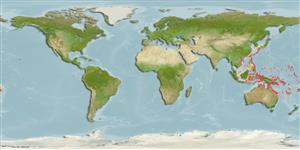>
Gobiiformes (Gobies) >
Gobiidae (Gobies) > Gobiinae
Etymology: Fusigobius: Latin, fusus = spindle + Latin, gobius = gudgeon (Ref. 45335); gracilis: Named for its being the most slender among its congeners.
More on author: Randall.
Environment: milieu / climate zone / εύρος βάθους / distribution range
Οικολογία
Θαλασσινό(ά) βενθικό(ς); εύρος βάθους 6 - 18 m (Ref. 41649). Subtropical
Western Pacific: Ryukyu Islands to the Great Barrier Reef and New Caledonia, east to Fiji.
Μέγεθος / Βάρος / Age
Γεννητική Ωρίμανση: Lm ? range ? - ? cm
Max length : 4.2 cm SL αρσενικό/απροσδιόριστο; (Ref. 41649); 3.0 cm SL (female)
Short description
Κλείδες προσδιορισμού | Μορφολογία | Μορφομετρία
Ραχιαίες άκανθες (συνολικά) : 7; Μαλακές ραχιαίες ακτίνες (συνολικά) : 9; Εδρικές άκανθες: 1; Μαλακές εδρικές ακτίνες: 8; Σπόνδυλοι: 26. Diagnosis: Dorsal rays VI - I,9. Anal rays 1,8. Pectoral rays 17-19 (usually 18). Longitudinal scale series 25. Head naked except for scales on side of nape reaching nearly to above upper end of preopercular margin; posterior nostril not close to orbit. The body is slender, depth 5.45-5.75 in SL; snout length 3.0-3.4 in head; first dorsal fin not higher than second; second dorsal spine usually longest, 5.35-5.8 in SL. Pelvic fins fully joined medially by membrane (when intact); pelvic frenum absent. Body translucent with numerous very small orange-yellow spots with blackish centers on head and body, those on head arranged in oblique rows; a black spot the size of pupil or smaller at midbase of caudal fin; a second smaller blackish spot just above base of pectoral fin; dorsal and caudal fins with orange-yellow spots; a dusky orange line from upper part of first membrane of first dorsal fin to base of second spine (Ref. 41649).
Body shape (shape guide): fusiform / normal.
Inhabits sand-rubble bottoms next to reefs in 6-18 m (Ref. 90102).
Life cycle and mating behavior
Γεννητική Ωρίμανση | Αναπαραγωγή | Γεννοβολία | Αβγά | Γονιμότητα | Προνύμφες
Randall, J.E., 2001. Five new Indo-Pacific gobiid fishes of the genus Coryphopterus. Zool. Stud. 40(3):206-225. (Ref. 41649)
IUCN Red List Status (Ref. 130435: Version 2025-1)
Threat to humans
Harmless
Human uses
Εργαλεία
Special reports
Download XML
Διαδικτυακές πηγές
Estimates based on models
Preferred temperature (Αναφ.
123201): 24.9 - 29.3, mean 28.5 °C (based on 1509 cells).
Phylogenetic diversity index (Αναφ.
82804): PD
50 = 0.5005 [Uniqueness, from 0.5 = low to 2.0 = high].
Bayesian length-weight: a=0.01023 (0.00477 - 0.02194), b=3.01 (2.83 - 3.19), in cm total length, based on LWR estimates for this (Sub)family-body shape (Ref.
93245).
Τροφικό Επίπεδο (Αναφ.
69278): 3.2 ±0.3 se; based on size and trophs of closest relatives
Ελαστικότητα (Αναφ.
120179): Υψηλό, ελάχιστος χρόνος για διπλασιασμό πληθυσμού < 15 μήνες (Preliminary K or Fecundity.).
Fishing Vulnerability (Ref.
59153): Low vulnerability (10 of 100).
🛈
